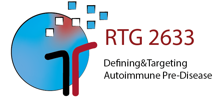MD A27: Deciphering the signaling events in collagen type VII antibody-induced pathology
Epidermolysis bullosa acquisita (EBA) is a rare subepidermal, chronic autoimmune blistering disease caused by autoantibodies against type VII collagen, which is a component of the anchor fibrils of the dermo-epidermal junction zone. There are two variants of EBA: an inflammatory and a mechanobullous (non-inflammatory) variant. The mechanobullous variant is characterized by skin fragility, traumatic blisters, and scarring. In contrast, the inflammatory variant is characterized by widespread erythema, ulcerative plaques, and blistering with less pronounced scarring, and is thus similar to other autoimmune blistering diseases. In addition to the loss of immune tolerance to type VII collagen, patients develop IgG - and, to a lesser extent, IgA autoantibodies – that bind to the NC1 domain of type VII collagen. This triggers complement activation and recruitment of inflammatory cells, ultimately resulting in dermal-epidermal separation. Current treatment options are often insuOicient, particularly in refractory cases, and carry significant risk due to longterm immunosuppression.
This project compares the signalling mechanisms triggered by epidermolysis bullosa acquisita (EBA) autoantibodies in oral and skin keratinocyte cultures, in order to understand why therapeutic responses may diOer between skin and mucosal tissues. Keratinocyte cell lines are incubated with anti-COL7 autoantibodies (IgG1 and/or IgA2), and the resulting signalling events and changes in gene expression are analysed, with a particular focus on their impact on cytokine production and other cellular processes. To capture the dynamics of these processes, cells are stimulated at diOerent time points, followed by chip-based kinome profiling (PamGene) and RNA sequencing to comprehensively assess signalling activity and transcriptional responses A deeper understanding of these processes may explain diOerences in skin and mucosal involvement and could help identify novel therapeutic targets for the treatment of autoimmune blistering diseases.

- Projects
- 1st Generation
- 2nd Generation
- A: Defining Autoimmune Pre-Disease
- B: Targeting of Autoimmune Pre-Disease
- Associated projects
- Medical doctoral researcher projects
- MD A21: Antibodies targeting angiotensin II type 1 receptor as a putative mediator of driving endothelial dysfunction
- MD A23: Investigation of the association of pulmonary fibrosis with tumor-associated antigens and their autoantibodies in systemic sclerosis
- MD A25: Unresolved epidermal reactivity: Predisease forms of autoimmune blistering disorders?
- MD A26: Three-dimensional skin equivalents for pemphigoid research
- MD A27: Deciphering the signaling events in collagen type VII antibody-induced pathology
- Concluded projects
Medical doctoral researcher

Participating Researchers


Mentor



